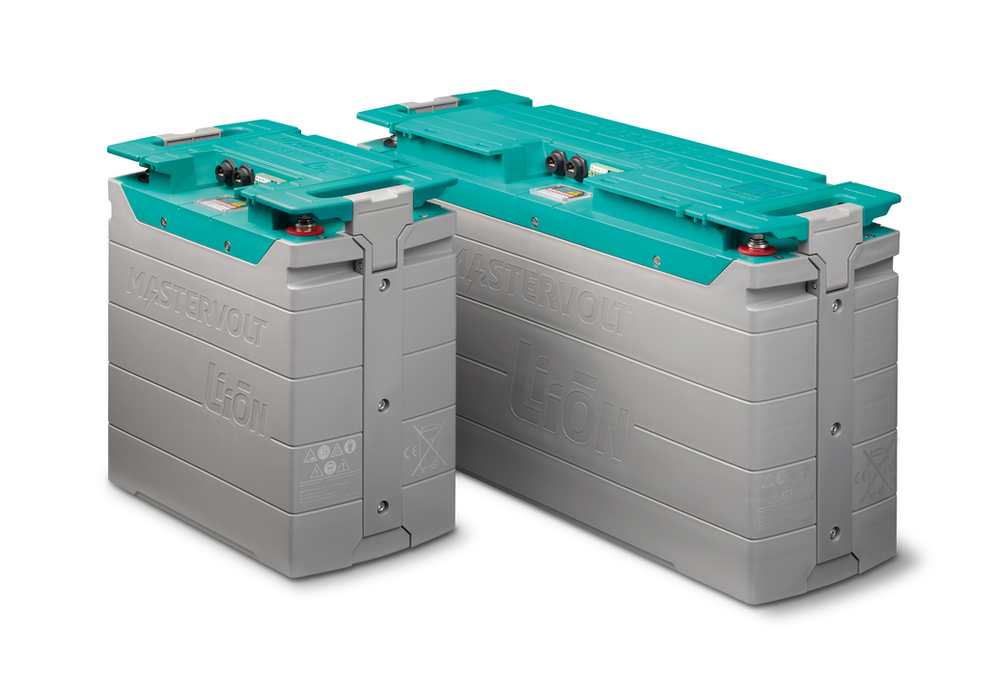In Focus: Unpicking the ‘dark art’ of lithium-ion batteries

“I can talk about lithium-ion all day,” says Nick Holland (director – OEM marine division EMEA at Navico Group). “It’s a bit of a dark art for many people. They say they’re not going to go there as it ‘looks like a can of worms’. Well, it’s not.”
Holland has been involved with Mastervolt, part of Brunswick Group for over a decade. The company first started its journey to lithium-ion batteries in 2009.
“Because we came into the market, the learning curve for us – for me and the engineering team – was vertical,” says Holland. “We’re on our fourth-generation battery now.”
Holland notes that the current range (a number of different size and different voltages) is fourteen years in development and, in that time, the technology has focused on building safety parameters within the battery itself. Thus, Mastervolt has created a battery management system which enables every device that puts energy into the battery bank (and the battery itself), to talk to each one individually.
Smart battery technology
“You need some really smart technology that works in a completely automated way, and protection around the installation and the battery to make it safe,” says Holland. “That means the tech needs to be automated and it needs to cover all eventualities. So if you have an over voltage the battery needs to be able to switch the charging sources off. If you have a really deep discharge (which can happen if the battery’s not set up properly) you need to be able to disconnect the loads from the battery to stop pulling more current from an already deeply discharged battery. You need to be able to turn the battery off if you have something like an over-temperature in one of the cells.
“We can disconnect loads,” he continues. “We can send a ‘stop charge’ command for a period of time – say ten minutes while temperature reduces or while the battery equalises itself out. There is a lot of clever stuff that we can do.
“To be able to do that, you need some additional products, which is where Navico Group comes in. You need additional relays and battery switches and ways to switch some of those external devices on. We’ve got a battery that can do that itself. It’s talking to the charging devices. It’s talking to the alternators, the battery chargers, the solar chargers, anything that generating energy which is going into the lithium-ion battery bank.
“The battery knows exactly what’s going on inside itself and inside the cells. So the battery can say ‘hang on a minute, I’m getting full, stop sending me lots of energy’. The battery will turn the alternator off even if the engine is still running. If the battery’s being charged by a battery charger, the same thing. If it’s getting full, it can say to the charger or ten chargers — it can say to them all “I’m full, stop charging’.”
Holland has previously cited battery development as enabling Fathom to come to fruition, (a complete e-power management system, essentially a silent running system which generates, stores, converts and distributes AC power), but he notes that not all lithium-ion batteries are developed like Mastervolt’s.
“People should worry about lithium-ion batteries, depending on where they get them from. It’s a technology that’s been around for quite a long time and there are different types of lithium-ion tech. Some of it is very high density but is very unstable, some of it is completely stable but not very high density, and you get some stuff in the middle.

“For responsible manufacturers who are selling the technology, they tend to err on the side of caution on the types of lithium-ion they are fitting in their batteries. We use LifePO4 which is a technology that is proven. It’s relatively stable and has got quite good density properties. So it makes a nice battery.”
Even though the properties might be proven, Holland warns against bad installations.
“I’ve seen problems occur many many times over the years where people are installing batteries without proper training, without any protection, or because they’ve cut corners – perhaps thorough lack of knowledge, or being lazy.
“Normally when you’ve got a problem on a boat with a lithium-ion battery, 99 per cent of the time, it won’t come down to a bad battery. It will come down to a poor installation that hasn’t had the necessary protection and safety around the outside of it to stop an event happening. An event could be a fire aboard a vessel. You need to have steps in place before you’ve ever got enough heat in the system to start a fire.”
This issue was highlighted in MIN in June 2022, as some insurance companies were refusing to insure boats with retro-fitted self-installations onboard.
“Everyone is driving these Teslas around and they’re not going up in flames. And we’ve all got mobile phones in our pockets and they’ve all got lithium-ion batteries in and they’re not going up in flames, that’s because all of these things have protection to stop that happening and it’s the same with a vessel. If you’ve got the right protection in, which has been set up by the right people who know what they are talking about, you’re not going to have any issues.”
Installation maturity
Because of the battery’s rich internal tech, Holland says installation has matured over the years. Where once installers had to introduce protection into the system via a laptop, “standards in terms of what we want the battery to do (if this then do that) is now automated within the battery itself. Battery ‘events’ are built in . But you still need an element of expertise to install them. That’s why we’ve got a pretty comprehensive training programme for our installers, our technical partners, our dealers – so that they can install safe reliable systems.
“For every lithium-ion installation, we will create a schematic for the client – everything will be on there. We have a set of practices and go through a number of stages to install the batteries, to commission them. Then we have a testing process to make sure all the safety aspects work. We create ‘false’ events to test the battery can turn off the chargers, the alternators, the solar regulators, the wind generators, the hydro generators. That’s the first thing we do. We make sure we can control everything on the network, then we make sure we can do other stuff like turn things back on. We don’t need user intervention to start doing things if things go wrong. All of the security and safety aspects are built in.
“There’s not much I haven’t seen about lithium-ion over the years,” concludes Holland. “If you just understand it and how to do it properly, it’s really safe.”










